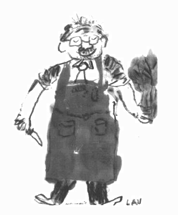go to WASHINGTON FREE PRESS HOME (subscribe, contacts, archives, latest, etc.)
Jan/Feb 2001 issue (#49)
|
|
Blues and Greens: a produce worker's journal
by Alan Chong Lau
University of Hawai'i Press 2000
115 pages paperback, $17.95

Self portrait by writer Alan Chong Lau |
Alan Chong Lau has practiced the Buddhist virtue of right livelihood more perfectly than any other artist in Seattle. In the last twenty years he has painted light and sumptuous sumi-e and exhibited them at the Francine Seders gallery, published two collections of supple poetry, edited a lively Asian American arts section for the International Examiner, including regular literary supplements, and worked daily in the produce department of Uwajimaya. It is hard to imagine a more balanced and rooted artistic life. Lau's latest poetry book, Blues and Greens: a produce worker's journal, is a fine summation of that life, alternatingly observant, earthy, comic, and elegant.
Lau's eye is trained by painting, his hearing by poetry, and his other senses by a lifetime spent attending to vegetables and fruit. His poems' natural detail is one of their great strengths. In Blues and Greens Lau captures the life around him down to the curved shell of a shopper's ear or the hair of a female Mexican farmworker found in a box of sugar peas. Lau's poetic voice is direct and personal; he doesn't create poetic personas but speaks from his own experience and memory. When he tastes the grocery store's Chinese river potatoes he remembers the ones his grandmother would find in California's Central Valley. One day he goes into a back room at the store and finds his whole produce crew huddled around a life-and-death struggle. They're counting how long it will take a black widow spider to wrap its sticky thread around a captured wasp's stinger:
"They all begin to shout
as the spider twirls
its legs into a dance
'Get him, get him, get him
You bad boy!'"
(the last stanza of "boys at play")
Lau's sensibility embraces the coarse as well as the fine. He knows the stink of yesterday's piss in the alleyways, and notices what lies in the gutters, whether it's cherry blossoms or trash. He lets us in on the jokes he sees around him: the seagull droppings on the Piece of Cake bakery; the boy picking up a taro root and calling it his "chin chin," a child's word for penis. He makes the reader feel the itchy sensation of a winter melon's prickly hair on a hot summer day, or the smell of the brine and guts from the fish department, or the horrible grating of one customer's voice like that of an alley cat with "rusty razor blades sewn in its rump."And in some special poems like "three lumpy oranges" he finds the perfect words to transmute that coarseness into a severe beauty:
"At dumpster's bottom
three lumpy oranges
cool off
in a pool of fish blood"
Lau is intrigued by the human comedy around him. Why, he asks, does that man wear a cub scout hat that's one size too small, or the pudgy boy a "Hunk" t-shirt? Chinatown, he realizes, is as much about the two guys in baseball caps simultaneously yawning one morning across from Union Station as any carved stone lions guarding a stylized gate. My art history professor, Dr. John Fitzgibbon, used to say that there was more violence in the supermarket than in Vietnam. In a number of poems Lau shows that anger and aggression spilling out in the produce section: tired working women pushing and insulting each other as they scour over the river potatoes, the gambler's wife bossing the grocery workers, an annoyed woman waving away help as she unties bundles of bok choy to get at the heart of each.
The most successful poems in Blues and Greens elegantly capture a haiku aesthetic in contemporary English. In the poems "winter melon," "green mustache," "frost warning," "bitter melon," "the end of spring," and "green onions" Lau arranges handfuls of common words to create moments of insightful beauty. For example, this is the full poem "green onions:"
"Sitting down to supper
the smell of a day's work
still rises from
my stained hands
to fill our soup bowl"
The poem resonates with a tender intensity; we know that moment, its smell and its feelings. As with all strong haiku, Lau reveals a single experience of the natural world and we remember that our lives are made of just such simple moments. And we realize that the more we pay attention, as Lau does, the more we live.
Lau's first published poems were in the exuberant joint collection The Buddha Bandits Down Highway 99, a 1978 book that also included work by poets Garrett Kaoru Hongo and Lawson Fusao Inada. Lau's Buddha Bandit pieces were either prose poems rich in historical detail or lyric poems that journeyed through geography and memory. In his second book, Songs for Jadina, published in 1980, Lau went deeper into his family's past, writing lyric poems of great emotional depth.
Now in Blues and Greens he's gazing at the elusive surface of the present moment, often capturing it but sometimes missing, as in the poem "the accident," which adds no insight to the dull story of a woman who slips in the produce section and ends up suing the store. Overall, this is a strong collection of poems. Like the eighteen gentle sumi-e interspersed among them, these poems transform customers and produce into art.
|
go to WASHINGTON FREE PRESS HOME |